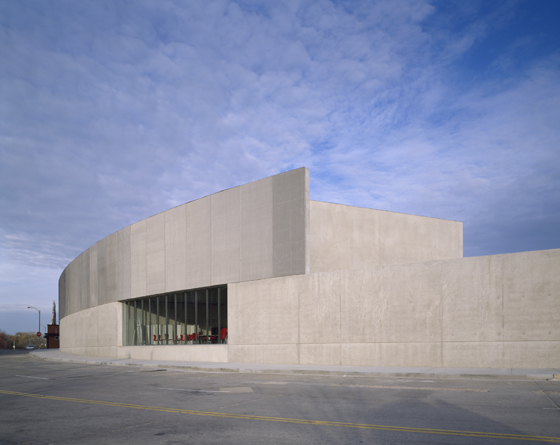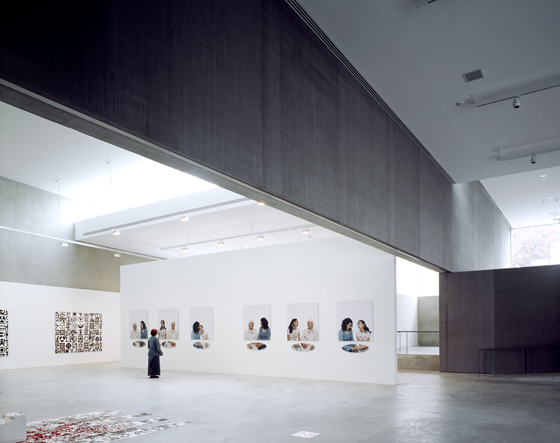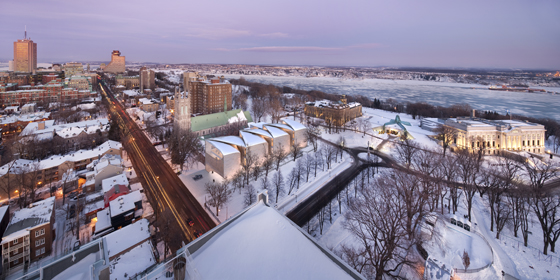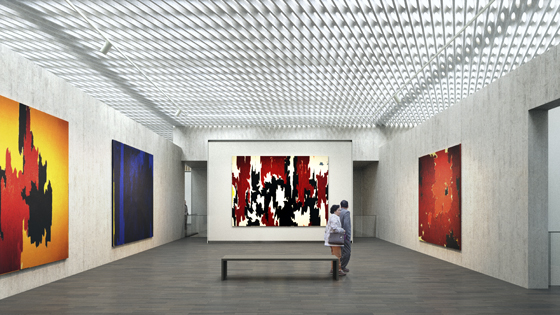Quiet Musings: Brad Cloepfil
Text von David Sokol
Washington, DC, USA
25.02.11
A series of new architecture commissions and exhibitions suggests that museums are no longer in the business of pageantry. In this second part of a series examining post-spectacle museums, architect Brad Cloepfil talks about the phenomenon of 'collecting' cultural architecture, and how his own museum designs aim both for spectacle and counterpoint with it.
'"Small Scale, Big Change" was a great show, because it wasn’t about museum architecture! It was all about specificity – architects who find their architecture in the nature of an institution, the scale of the city, local construction techniques.' Portland, Oregon-based architect Blad Cloepfil only has positive things to say about Andres Lepik’s exhibition at the Museum of Modern Art, yet the commentary has a bit of an edge. It suggests that most museums’ architecture exhibitions are self-congratulatory and, more pointedly, that they museum architecture so often on display in these shows lacks a sense of place. As Cloepfil puts it, 'There are the architects who bring their circuses to town, and certainly the tents are different because they’re dealing with a different site, but it’s the same bag of tricks.'
The two-storey Contemporary Art Museum St Louis is located in the namesake city's Grand Center District, adjacent to the Pulitzer Foundation for the Arts. Ribbons of concrete and stainless-steel mesh characterise the modest building

The two-storey Contemporary Art Museum St Louis is located in the namesake city's Grand Center District, adjacent to the Pulitzer Foundation for the Arts. Ribbons of concrete and stainless-steel mesh characterise the modest building
×Like every architect, Cloepfil’s body of work embodies a particular vocabulary of architecture. But his multiple museum projects are not separated at birth. Cloepfil says he never even thought he would be contributing to the building type, adding,'When I was a graduate student, I was so abhorred by the neo-historicism and pastiche [that characterised museum design] that I looked to artists for inspiration.' It was just that fluency with contemporary art concepts that propelled Cloepfil into the world of architecture in the service of art.
Major projects in the realm include Maryhill Overlook, Contemporary Art Museum St Louis, the expansion of the Seattle Art Museum and of the University of Michigan Museum of Art, and the forthcoming, all-new Clyfford Still Museum and National Music Centre Canada. Although Cloepfil’s most publicised project, the redesign of Edward Durell Stone’s 2 Columbus Circle into the Museum of Arts and Design, earned only mixed reviews, it shares with this entire range a sense of introspection, of structural innovation expressed as spatial experience, and of respect for the existing place. It is not a circus that can be described solely in terms of uniform materiality, form, or other motif.
At 55, Cloepfil has gained renown as a soulful practitioner – he operates mostly in charcoal – who is deeply inspired by the landscape of his native Pacific Northwest and by context in general

At 55, Cloepfil has gained renown as a soulful practitioner – he operates mostly in charcoal – who is deeply inspired by the landscape of his native Pacific Northwest and by context in general
×'Operations, fundraising, cultural context, board members – with cultural buildings, architecture is a small part of getting a project done,' Cloepfil also notes. And perhaps for that very reason he believes in museum architecture that is both thoughtful response and saleable image. 'Signify is what buildings do. Architecture is immutable, it’s visceral, and it’s in real time. People respond to that, and they always will,' he explains. Offering a preview of themes that run through his first book coming out this spring, Cloepfil speaks with Architonic about the many variables of designing museums that are places as much as icons.
Lower walls define the Contemporary Art Museum St Louis's exhibition galleries, and their folding motions are intended to draw in the public. A diversity of interior volumes create different daylighting and programming conditions within this larger space

Lower walls define the Contemporary Art Museum St Louis's exhibition galleries, and their folding motions are intended to draw in the public. A diversity of interior volumes create different daylighting and programming conditions within this larger space
×....
Let’s jump right in. Are we in a post-spectacle age?
We were just in the finals of the World Architecture Festival, and it is exactly spectacle. If you looked at all the boards lined up, it was a lot of architecture trying to outdo itself. Or take Abu Dhabi. This has everything to do with a country’s or city’s self-image. If it feels it needs to elevate its cultural capital in a very public way, then there’s going to be sensational architecture for the foreseeable future. I think the post-spectacle question is more valid in places where cultural sense of self is more developed.
Are there other reasons spectacle continues a stronghold in architecture?
I think it’s a number of things. I think it starts with a return to figural architecture after the sombre commercial modernism of the mid-century through the 1980s. Before modernism, there were spectacles of scale and grandeur, like St John’s Cathedral or Rockefeller Center; there’s always been a need for architectural presence made identifiable through iconography or monumentalism or excessive style. The emergence of postmodernism and historicism in the 80s brought back gesture, and it completes the evolution of spectacle, of the building as an image.
There were other factors, like Bilbao searching desperately for an economic engine. And software allowing us to create architecture as graphic design. All of those factors enter into it. But if you look at the cultural evolution, there’s a clear logic to all of it.
Allied Works' proposal for a new pavilion for Musée national des beaux-arts du Québec features five interlocking, cantilevered concrete shells

Allied Works' proposal for a new pavilion for Musée national des beaux-arts du Québec features five interlocking, cantilevered concrete shells
×Did you make a conscious decision to ignore those factors?
My first museum project was for the Portland Institute of Contemporary Art. Its founder, Kristy Edmunds, and I could just talk and talk about the ideas she was interested in. The architecture starts with that kind of relationship, and the body of artwork those ideas relate to.
My work has a specificity that I think is the opposite of image. It also starts with the place. Maryhill Overlook was an introspection of landscape; the Contemporary Art Museum St Louis was introspective about urban St Louis at that time and what it meant to make a non-collecting art museum in the early 21st century.
It seems like spectacle buildings are often commissioned because someone says, 'I want one of those, too.' Your approach seems antithetical to the gimme impulse.
I think people want a cultural building that represents the ideals and ethics of their community, theoretically. But there’s a disconnect. One would think they would commission architecture that would be specific to the conditions of that community and its ideals. Instead, they wind up collecting architecture: The client saw something in Abu Dhabi and wants a version of it in Hoboken. There’s a distinction between collecting architecture and commissioning architecture.
Toyo Ito is a great example. He’s fantastic, and we were honored to be on the same shortlist with him for the Berekeley Art Museum. He invents something every time. Whereas, with other architects, every building is a restatement of the same form or ideas. The majority of architecture is commodity.
Allied Works Architecture was chosen to design the Clyfford Still Museum in 2007. Undulating concrete walls and a grove of trees create an organic contrast to Libeskind's Denver Art Museum next door. Inside, concrete lattices characterise the galleries

Allied Works Architecture was chosen to design the Clyfford Still Museum in 2007. Undulating concrete walls and a grove of trees create an organic contrast to Libeskind's Denver Art Museum next door. Inside, concrete lattices characterise the galleries
×Not to sound like an apologist, but couldn’t you argue that every creative person has a certain language of concept or expression, and that those restatements are actually refinements of that lifelong idea?
It could be an iterative artistic process, and thank you for boring more deeply into the subject. Certainly my projects are in conversation. All artists and architects carry certain thoughts forward: You learn from one project and you take some of that learning to the next project. But I do think you can look at a building that is so closely related formally, spatially, experientially, to two other buildings that it seems to respond to nothing specific about a climate, culture, site, the fundamental nature of the institution – the design is merely a modification of language.
Couldn’t it be, too, that behind such a project there’s a 'I want one of those' donor with deep pockets?
We’re getting into a place where there’s a lot of grey area. With cultural buildings, there’s a tendency for cities or institutions to want to engage very prominent architects, very high-visibility architects, because they understand that their cities deserve them, and also because name and status and images helps raise money. Quite often there’s a pool of potential donors who are not overly familiar with architecture, so you can get those donors invested in known entities rather than an unknown architect who could make something equally transcendent.
Allied Works was selected over Diller Scofidio + Renfro for the Clyfford Still Museum. The visitor sequence begins below the earth, while nine upper-level galleries change in scale and proportion in response to the evolution of Still's artwork

Allied Works was selected over Diller Scofidio + Renfro for the Clyfford Still Museum. The visitor sequence begins below the earth, while nine upper-level galleries change in scale and proportion in response to the evolution of Still's artwork
×By 'spectacle', then, perhaps we should really say 'commodity spectacle'? A phrase that suggests not entirely thoughtful consumption of iconic architecture.
We were in the finals for a museum in Quebec City, and the design was probably one of the most important we’ve ever made. We came in second to Rem Koolhaas. Rem is an amazing architect, but I will say that our form was very specific to place – the solution came absolutely from that place. It was quiet, to a certain extent, but it was exceptionally beautiful and people responded to it viscerally. Isn’t that spectacle, too? Getting to your point, you want people to respond, Wow! You want people to be really moved by something – and then you want them to figure out why they were struck so deeply by it.
So in defence of the cultural and economic leadership of these cities and states, they’re looking for things that are engaging and new. And the fact that most of the things that are produced are image-led is not their fault. There just aren’t that many times that any of us get to walk into a space or look at a form and just be incredibly moved by it, not to mention to walk into that same space ten years later and feel the same.
Would you describe how your Musée National des beaux-arts du Québec is of that place?
I think there were three features. We treated the site as a promenade; it’s an experience of serial interlocking structures, which carries you from the street and into the heart of the museum complex. Yet these large structural shells lift off so that the ground itself is virtually transparent. The sacred ground of Canadian history actually rolls through the base of the building.
The rhythmic structural order also related to the historic context. Surrounding the site is a neo-Gothic cathedral, a prison, and the original Beaux-Arts museum pavilion. So the repetitive structure weaves into that composition. And then there’s the incredible northern light. The shells really strives to bring that light into the galleries.
This wasn’t a form I’ve done before, and not since. Through an iterative introspective process of discovering the place, though, we found that form. Occasionally in your career you’re lucky enough to find that thing that resolves every question in the best way you can possibly imagine. It’s an ongoing search, and you don’t always get there.
Brad Cloepfil leans over one of the roughly fashioned worktables in his Portland, Oregon, studio. The converted Elk's Lodge is home to 35 employees; his New York studio, open since 2002, includes a staff of 15

Brad Cloepfil leans over one of the roughly fashioned worktables in his Portland, Oregon, studio. The converted Elk's Lodge is home to 35 employees; his New York studio, open since 2002, includes a staff of 15
×What about the Clyfford Still Museum, which is nearing completion – among other things, how did you resolve the design to the proximity of Libeskind’s Denver Art Museum?
We took the approach that you have all the extroversion in the world right next door, whereas Still’s work is intensely individual – the viewer has a physical and psychic relationship with his painting. So it became a very introverted and grounded building. Part of that design has to do with cultural context, part of that refers to the nature of the artwork, and part of that has to do with the things I’m interested in.
What things?
I think the success of my career, such as it is, is that when people walk into the spaces, they are absolutely moved in ways they weren’t expecting, and in ways that I think are enduring. We still get that response with Wieden+Kennedy, which doesn’t have an exterior, and with St. Louis, whose interior is less quiet than the exterior might have led them to expect.
Some architects have admitted that they’re interested in form and sculpture and shape, and that’s it. I care deeply about the specificity of a problem, and I care deeply about structure as a kind of driving form-giver. Just by those ethics, and by the fact that I am one individual, you’re going to have a commonality of form among my buildings. But I wouldn’t say there’s a commonality of image.
And so we live in a time in which your brand of spectacle can coexist with commodity spectacle?
I would say there are modalities of culture, where some are more image- and status-obsessed, and others get more introspective, wanting something more visceral and experiential and particular. Just as I’m finishing up the Still Museum, Nouvel is doing museums in Qatar that are gorgeous, spectacular; I can’t wait to walk through those buildings. I don’t know why they exist and what’s in them, but that’s a totally different issue!






